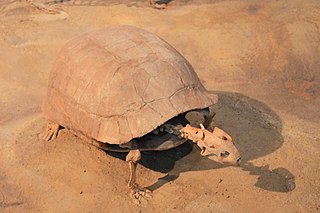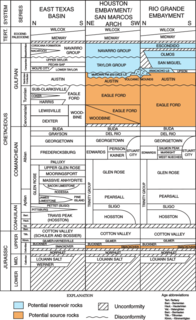This article contains a list of fossil-bearing stratigraphic units in the state of New Mexico, U.S.

Stylemys is the first fossil genus of dry land tortoise belonging to the order Testudines discovered in the United States. The genus lived in temperate to subtropical areas of North America, Europe, and Asia, based on fossil distribution. The genus was first described in 1851 by Joseph Leidy. The tortoise was common in the prehistoric Badlands, especially Nebraska and South Dakota. The species has also been found in the formations in and around Badlands National Park. Fossil fragments have also been found in the Palm Park Formation of New Mexico.
Redondasaurus is an extinct genus of phytosaur from the Late Triassic of the southwestern United States. It was named by Hunt & Lucas in 1993, and contains two species, R. gregorii and R. bermani. It is the youngest and most evolutionarily-advanced of the phytosaurs.

Metoposauridae is an extinct family of trematosaurian temnospondyls. The family is known from the Triassic period. Most members are large, approximately 1.5 metres (4.9 ft) long and could reach 3 m long. Metoposaurids can be distinguished from the very similar mastodonsauroids by the position of their eyes, placed far forward on the snout.
Xiaoming Wang is a Chinese-born American vertebrate paleontologist and geologist who lives and teaches in the United States.
Lafonius is an extinct genus dvinosaurian temnospondyl within the family Trimerorhachidae. It is known from Carboniferous of New Mexico.
Macrocephalochelys is an extinct genus of turtles in the family Chelydridae. It was first described from a partial skull from the Pliocene found in Ukraine by Piboplichko and Taraschchuk in 1960. It was assigned to the family Chelydridae by R. L. Carroll in 1988 although it had been hypothesised to belong in Chelydridae by Chkhikvadze in 1971.
Mexichelys is an extinct monotypic genus of sea turtle which lived in Mexico during the Cretaceous. The only species is Mexichelys coahuilaensis. Mexichelys was erected in 2010 as a replacement name for Euclastes coahuilaensis, a species named in 2009.

Stockoceros is an extinct genus of the North American artiodactyl family Antilocapridae, known from Mexico and the southwestern United States. Its horns are each divided near their base into two prongs of roughly equal length.

The Wilcox Formation is a geologic formation in Tennessee. It preserves fossils dating back to the Paleogene period.
The Java Formation is a geologic formation in Kentucky, New York, Ohio, Pennsylvania, Tennessee, Virginia, West Virginia. It preserves fossils dating back to the Devonian period. The formation comprises the Pipe Creek Shale, Wiscoy Sandstone Member in New York, and Hanover Shale Member except in Tennessee.

The Navarro Group is a geologic group in Arkansas, Texas and Coahuila, Mexico. It preserves fossils dating back to the Cretaceous period.
The Benevides Formation is a geologic formation in Texas and Mexico. It preserves fossils dating back to the Cretaceous period.
The Colorado City Formation is a geologic formation in Texas, United States. It preserves fossils dating back to the Triassic period.
The Mural Limestone is a geologic formation of the Bisbee Group in Arizona and Mexico. It preserves fossils dating back to the Cretaceous period.

Tetrameryx is an extinct genus of the North American artiodactyl family Antilocapridae, known from Mexico, the western United States, and Saskatchewan. The name means "four [horned] ruminant", referring to the division of each horn near its base into two prongs; in T. shuleri, the rear prong is much longer.
| Wikisource has original works on the topic: Paleontology in the United States#New Mexico |
{{cite web}}: |author= has generic name (help)